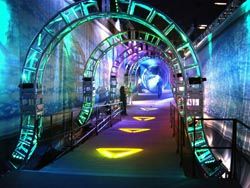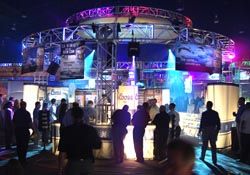The Coors Annual Distributors meeting in Caesar's Palace in Las Vegas was designed to look and feel like the inside of a pinball machine.The Promotions Room at Coors Brewing Companys annual distributors meeting at Caesars Palace in Las Vegas was designed to look and feel like the inside of a giant pinball machine.
In a dazzling display of lights, video, and audio, the annual get together became a larger than life event, causing attendees to wonder what they had just stepped into. Coors and their marketing team from Integer Group, hired Nashville based Q Productions to put together an exhibition for its distributors that would differ in scope from previous events. One that while allowing plenty of interaction between the distributors and the brand reps, would also wow the attendees. Chris Simmons, the Creative Director at Q dreamed up the giant pinball concept. Q hired freelance Production Manager Howard Jones to help bring the design to life. Howard is also the owner of Digital Console Rental, Inc. in Nashville, the digital audio console provider for the event.
Simmons, Jones and Stephen Isbell, the owner of Q, worked closely with one another to develop the truly original idea. Jones explains, Chris came up with a pinball machine theme, as if the whole expo was one and you were inside it. The different brands under the CBC umbrella all were to have booths that represented the bumpers. We had 49,000 square feet in the Events Center at Caesars to work with and we wanted to utilize the entire space, so we wrapped the entire room in a digitally printed graphic that gave you the illusion you were in a pinball machine looking out.
Sound Solutions
Putting together such a large illusion required the right gear. Audio would play a critical role in achieving the atmosphere of being inside a pinball machine, starting with the right console. Jones provided the console from his company for the show, Q hired Dave Thomas of FOH Productions to be the operator. From an audio standpoint, we wanted to create the environment that you were audibly as well as visually inside of this pinball machine, says Jones. The concept that Dave and I developed consisted of 40 different zones of audio. My company, Digital Console Rental, Inc., had just purchased Digidesigns Profile and D-Show VENUE systems. While I was anxious to use one on this event, I was wary because of the number of busses needed. The VENUE system at first glance has 16 auxes and eight variable groups, so there was concern as to whether it had enough discrete busses to pull this off.
Jones contacted Jeff Priepot of Digidesign to discuss the event and see if the console was capable of such a massive undertaking. Jeff was confident it could and explained all the possibilities using the known auxes and groups as well as the PQ Monitor, Matrix and other busses available, continues Jones. After speaking with Jeff, Dave and I were convinced we were on the right track, we agreed on the VENUE system with the D-Show control surface. Within the audio design, we also had on hand a Digidesign Pro Tools|HD system, which we were able to directly interface with the console via the HDx card in the FOH rack. It was used to do a lot of the playback of the ambient pinball sounds as well as a special effect sequence that ran every 30 minutes following the debut of Coors Lights new TV commercial.

Over a mile of truss was used for the event, including for this ball entry area.
Be the Ball
To keep the illusion of a ball bouncing around, the team had to incorporate lights and video. The lights had to flash on each bumper as the ball hit. At the end of each interval, the ball went out the bottom of the machine, so to speak, on a video screen near the west end of the Events Center which depicted the ball going off into space on a free floating track and then disappearing. We had to timecode all this. Event though the commercial, the launch, ball movement and eventual ball exit were all separate pieces. Audio, video, and lighting were all locked together and felt as if they were one, adds Jones. The toughest part to get right was the actual entrance area. There were 10 speakers, five stereo pairs. Getting the time and the feel of the ball being loaded and moving past you was the biggest challenge. We used a wireless tablet to control the VENUE system. Clair Brothers / Nashville supplied the audio gear, they had a tablet that controlled all their systems as well. So between the two, we could dial in anything in the room.

Each Coors brand had its own booth, which would become a flipper or bumper for the when the "ball" would be "launched" into the arena, lighting up at the appropriate times.
The booths all contained their own systems for their individual program material as well as the pinball sequence. We were supplying a general pinball ambience in the room, but for each booth we had certain soundtracks, recalls Thomas. For example, one brand area had birds and animal sounds, another had Canadian bands playing and yet another had a virtual fireplace with crackling in the background. We were able to achieve this by using three separate Pro Tools systems. There was the Pro Tools|HD rig doing the whole pinball sequence and two others doing SFX for the booths. We were concerned about bleed over of the audio content of one brand area into another, so we had to make sure our sound design worked for that, using smaller speakers and localized coverage. But it took the longest time to create the whole pinball sequence, about eight hours of programming on Pro Tools. Jeff Priepot, and Ryan Lawless from Clair Brothers, worked on the majority of the tracks.
Each Coors brand had its own booth, which would become a bumper for the when the ball would be launched into the space, lighting up at the appropriate times.
Building Limitations
The facility itself provided a challenge for the team as they put the show together. The biggest issue was the rigging limitation in that building, sates Jones. Overhead beams were spaced ten feet apart running the length of the room and the roof was arched. We could only hang 750 pounds per side or a center load of 1500 pounds. So we had to develope the design with those limitations. We did a lot of ground-supported truss structures, and handled only cable management and the room wrap with flown truss. In the end there was almost 5500 feet of truss over a mile. It took a week of 16-hour days to get it all in and up. The truss was all from Tyler Truss, a division of Dodd Technologies, Inc. All the lighting was brought in from Christie Lights in Toronto, with lighting design by handled by Mike Lurz. MooTV, also from Nashville, handled all video elements.
The show was an astounding success, and all attendees were impressed by the clarity and creativity involved. As far as corporate audio goes, this show set a precedent of thinking outside the box, says Thomas. This is really putting the people inside the show. The biggest lesson learned was how much the Digidesign console was capable of. I was skeptical in the beginning if it was the right choice, but in the end it was great, I really enjoyed working on it.

